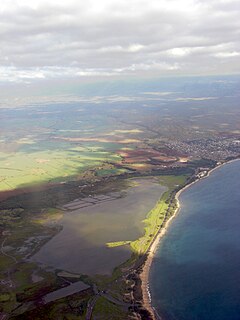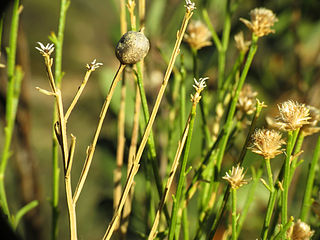
Kealia Pond National Wildlife Refuge is a coastal salt marsh along the south-central coast of the Hawaiian Island of Maui. The refuge is located between the towns of Kīhei and Māʻalaea, on both sides of North Kihei Road, Route 31. The wetland is also a 691-acre (2.80 km2) bird sanctuary, home to 30 species of waterfowl, shorebirds, and migratory ducks, including the ʻaukuʻu and the endangered āeʻo and ʻalae kea. Kealia Pond was selected as a wildlife refuge in 1953, protecting an initial 300 acres (1.2 km2) of land. The refuge joined the National Wildlife Refuge System in 1992.
Asheum is a genus of European non-biting midges in the subfamily Chironominae of the bloodworm family Chironomidae. It was originally named Pedionomus by James E. Sublette in 1964; this name was discovered by Dr. Patrick Ashe to be preoccupied by PedionomusGould, 1840, so it was renamed to Asheum by both James E. and Mary S. Sublette in 1983, naming it after Dr. Patrick Ashe. Asheum is sometimes considered to be a subgenus of Polypedilum.
Polypedilum vanderplanki or the sleeping chironomid, is a dipteran in the family Chironomidae. It occurs in the semi-arid regions of the African continent. Its larvae are found in small tubular nests in the mud at the bottom of temporary pools that frequently dry out during the lifetime of P. vanderplanki larvae. Under these conditions, the larvae's body desiccates to as low as 3% water content by weight. In the dehydrated state the larvae become impervious to many extreme environmental conditions, and can survive temperatures from 3 K to up to 375 K, very high levels of gamma-rays, and exposure to vacuum. It is one of few metazoans that can withstand near complete desiccation (anhydrobiosis) in order to survive adverse environmental conditions. Slow desiccation enabled larvae to synthesize 38 μg trehalose/individual, and all of them recovered after rehydration, whereas larvae that were dehydrated 3 times faster accumulated only 6.8 μg trehalose/individual and none of them revived after rehydration. Late Embryo Abundant (LEA), anti-oxidant, and heat-shock proteins may also be involved in survival. This species is considered the most cold-tolerant insect species, able to survive liquid helium (−270 °C) exposure for up to 5 min. with a 100% survival rate when desiccated to 8% water content.

Chironomini is a tribe of midges in the non-biting midge family (Chironomidae).

Polypedilum is a genus of non-biting midges in the subfamily Chironominae of the bloodworm family Chironomidae. This is probably the most species-rich of all chironomid genera. Larvae of Polypedilum may also be among the most abundant invertebrates in euthrophic ponds, reaching densities of up to 1200 larvae per square meter.
Polypedilum sordens is a species of midge in the family Chironomidae.
Mallota bequaerti is a species of syrphid fly in the family Syrphidae.
Aneurus simplex is a species of flat bug in the family Aradidae. It is found in North America.
Aradus acutus is a species of flat bug in the family Aradidae. It is found in North America.
Aradus borealis is a species of flat bug in the family Aradidae. It is found in North America.
Aradus shermani is a species of flat bug in the family Aradidae. It is found in North America.
Aneurus borealis is a species of flat bug in the family Aradidae. It is found in North America.
Gozmanyina majestus is a species of cosmochthoniid in the family Cosmochthoniidae.
Phloeosinus pini is a species of crenulate bark beetle in the family Curculionidae. It is found in North America.
Polypedilum braseniae is a species of midge in the family Chironomidae.

Aciurina thoracica is a species of fruit fly in the family Tephritidae.
Exochocepheus eremitus is a species of mite in the family Scutoverticidae.
Polypedilum tritum is a species of midge in the family Chironomidae. It is found in Europe.
Polypedilum ontario is a species of midge in the family Chironomidae.



